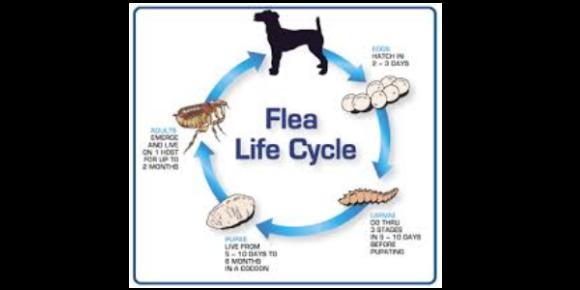
Fleas and Flea Allergy
Flea allergy dermatitis (FAD) or flea bite hypersensitivity is one of the most common skin diseases of dogs and cats in Alabama. It causes severe itching and can make your pet very uncomfortable during the summer.
Fleas bite through the skin and feed on your pet's blood. When they are feeding, they inject their saliva under the skin. Flea saliva contains many irritating chemicals that can cause an immediate itching reaction, like a mosquito bite on you. Some of the flea salivary proteins can bind to the skin collagen and are released slowly, resulting in prolonged skin irritation over several weeks. Some highly allergic pets may react to only a few flea bites, so even a mild flea problem can result in severe FAD.
In dogs, the itching from FAD is very intense and many dogs will cause self trauma to their skin, especially over the lower back, the base of the tail, and on their thigh areas. The front half of the dog from the ribs to the head is usually unaffected because they cannot bite at those areas. Over the back there is usually hair loss, reddish staining of the hairs where they are licking, redness of the skin, thickened darkened skin and crusts. Dogs often get secondary bacterial and yeast infections from all of the trauma to the skin. They may have a musty odor to the skin.
In cats, the primary skin reaction from flea allergy is to form a crusty rash called miliary dermatitis, which is found around the neck, face, and over the back, "like a racing stripe." This rash is itchy and red, causing the cat to scratch intensely.
To diagnose FAD, we look for fleas between the hairs on the skin. Sometimes we don't see fleas, so we will spray the coat with a rapid kill insecticide that will cause any fleas down on the skin to jump off the pet. Sometimes we will use a flea comb to see if we can catch any fleas. Also we look for flea dirt on the skin, which is the excrement of the feeding flea. It is actually your pet's blood. If we place some flea dirt on a damp paper towel it will turn a reddish color. Sometimes, dogs and especially cats are free of fleas because of excessive self-grooming.
FAD is best managed by flea control. The fewer times the flea bites through the skin, the less saliva is injected. We must try and control fleas by getting them off the pets, treating the environment to kill existing flea eggs, and preventing the environment from getting re-infested.
The first step is the elimination of existing pet flea infestations on the pet's skin. Topically applied flea products can take 12–36 hours to eliminate all existing fleas. The newer oral products cause the fleas to die within 4 hours.
The second step is to eliminate the existing infestation in the pet’s environment. This can be accomplished in two ways: The first is by using rapid acting long acting oral flea killers regularly that kill the female fleas quickly before they can lay any new eggs. Then the second step is the application of insecticides to the indoor premises to kill any live fleas in the carpeting, dog beds, and cushions. Most indoor flea products also contain insect growth regulators (IGRs) to prevent existing flea eggs in the environment from hatching.
Flea eggs are not sticky and can drop off the pet wherever the pet goes. Washing pet blankets, throw rugs, and cleaning pet carriers can remove fleas and flea eggs. In addition, pet sleeping and resting areas should be vacuumed thoroughly to help remove flea eggs and larvae. Remove the vacuum bag or clean the canister after every use to prevent flea eggs from hatching in the vacuum.
Elimination of fleas in the yard can be an important aspect of flea control. Yards can get infested with flea eggs by wildlife, feral cats and dogs, or other flea infested pets and should not be overlooked. Outdoor flea control with insecticide spray should be done to shaded areas such as dog houses, garages, under porches, and beneath shrubs. Sunny areas of lawn do not support adult fleas or flea eggs hatching, so those areas do not need to be sprayed. Repeated outdoor spraying every 2 weeks is recommended.
Treating a flea allergic dog or cat requires good flea control at home as well as medical therapy. Veterinarians will often use strong anti-inflammatory steroid type drugs to quickly stop the itching and give the pet some immediate relief. If there is any skin infection, oral antibiotics and/or antifungals will be prescribed. Frequent bathing with special shampoos will help the skin heal. As soon as flea control is accomplished and the skin disease is controlled, the anti-inflammatory therapy can be tapered to use a small amount of drug to keep the pet comfortable.
Your pet does not need to suffer through FAD. By working together we can provide relief...you do the flea control and we do the skin treatment.
